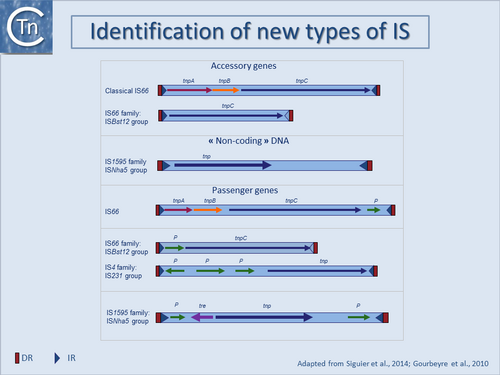General Information/tIS - IS and relatives with passenger genes

Over the past few years, a number of TE have been identified which are very closely related to known IS but which carry passenger genes not directly involved in transposition. These elements, simpler than known Tns, are called transporter ISs (tISs)[1] (Fig.9.1). Passenger genes include transcription regulators (e.g. ISNha5, members of the IS1595 family), methyltransferases (e.g. IS220, IS1380 family), and antibiotic resistance (e.g. ISCgl1, IS481family) genes and can be located upstream, downstream or on both sides of the transposase gene (Fig.9.1).
They can include a significant amount of DNA with no clear coding capacity (e.g.ISBse1, ISSpo3 and ISSpo8 from IS1595 family) and are longer than typical IS (e.g. ISCausp2, 7,915 bp, IS1595 family). This has presumably delayed their identification. Since the second IS end would occur at an unexpectedly distant position, they would resemble partial IS copies lacking a second end.
tISs are generally present in low copy number. Many occur only in a single copy in a given genome, raising the question of whether they are active. Moreover, more than one closely related but non-identical derivative can be found in a single genome (e.g. ISSpo3, and ISSpo8 in Silicibacter pomeroyi DSS-3 and ISNwi4 and ISNha5 in Nitrobacter winograski Nb-255). Others are present in more than one copy. ISPre3, an IS66 (see "IS66 family") relative from Pseudomonas resinovorans plasmid pCAR1 includes a hypothetical protein and is present as 2 copies with different insertion sites as judged by their typical 8 bp DR (Gourbeyre, unpublished).
The mechanisms involved in the acquisition of additional genes to generate tISs are at present unclear. They do not appear to carry programmed recombination systems, as do some members of the Tn3 family. One possibility is that tIS are derived by deletion from ancestral compound transposons. These are composed of two ISs flanking any DNA segment, either in direct or inverted orientation (see references in [2]). The flanking IS are able to mobilize the intervening DNA segment (Fig.9.1). They were among of the first types of transposon described and include the models Tn5 (flanking IS50) and Tn10 (flanking IS10) as well as Tn9 (flanking IS1 - see "IS1 family"). Since these early examples, many other such composite transposons have been identified either by experiment or from genome sequencing.
Some early observations concerning Tn5 and Tn10 suggest that the flanking IS can undergo mutation rendering them less autonomous (for example mutations within one IS which inactivate its transposase; see [3]). Furthermore, studies on IS101 from the pSC101 plasmid clearly indicated that transposition can occur using one established IS end and a second surrogate end located at some distance from the IS [4]. If, as in this case, the intervening DNA includes a passenger gene, this creates a novel transposon. It has also been observed that other ISs such as IS911 can use surrogate ends during transposition[5]. Moreover, isolated individual IS ends are often observed in sequenced genomes and could provide a source of surrogate ends. A number of potential transposable elements of this type, containing a single IS, a passenger gene and a short flanking sequence resembling an additional IS end, have been observed in nature. These include: colistin resistance (MCR-1)[6] which is associated with ISApl1[7][8], the fabI(Fatty acid biosynthesis) gene of Staphylococcus haemolyticus resulting in triclosan resistance and associated with IS1272[9] and the blaCTX-M-19 gene associated with ISEcp1B[10].
Bibliography
- ↑ Siguier P, Gagnevin L, Chandler M . The new IS1595 family, its relation to IS1 and the frontier between insertion sequences and transposons. - Res Microbiol: 2009 Apr, 160(3);232-41 [PubMed:19286454] [DOI]
- ↑ Craig NL, Lambowitz AM, Craigie R, Gellert M, editors. Mobile DNA II. American Society of Microbiology; 2002.
- ↑ Mahillon J, Chandler M . Insertion sequences. - Microbiol Mol Biol Rev: 1998 Sep, 62(3);725-74 [PubMed:9729608] [DOI]
- ↑ Machida Y, Machida C, Ohtsubo E . A novel type of transposon generated by insertion element IS102 present in a pSC101 derivative. - Cell: 1982 Aug, 30(1);29-36 [PubMed:6290079] [DOI]
- ↑ Polard P, Seroude L, Fayet O, Prère MF, Chandler M . One-ended insertion of IS911. - J Bacteriol: 1994 Feb, 176(4);1192-6 [PubMed:8106332] [DOI]
- ↑ Liu YY, Wang Y, Walsh TR, Yi LX, Zhang R, Spencer J, Doi Y, Tian G, Dong B, Huang X, Yu LF, Gu D, Ren H, Chen X, Lv L, He D, Zhou H, Liang Z, Liu JH, Shen J . Emergence of plasmid-mediated colistin resistance mechanism MCR-1 in animals and human beings in China: a microbiological and molecular biological study. - Lancet Infect Dis: 2016 Feb, 16(2);161-8 [PubMed:26603172] [DOI]
- ↑ Snesrud E, He S, Chandler M, Dekker JP, Hickman AB, McGann P, Dyda F . A Model for Transposition of the Colistin Resistance Gene mcr-1 by ISApl1. - Antimicrob Agents Chemother: 2016 Nov, 60(11);6973-6976 [PubMed:27620479] [DOI]
- ↑ Snesrud E, McGann P, Chandler M . The Birth and Demise of the ISApl1-mcr-1-ISApl1 Composite Transposon: the Vehicle for Transferable Colistin Resistance. - mBio: 2018 Feb 13, 9(1); [PubMed:29440577] [DOI]
- ↑ Furi L, Haigh R, Al Jabri ZJ, Morrissey I, Ou HY, León-Sampedro R, Martinez JL, Coque TM, Oggioni MR . Dissemination of Novel Antimicrobial Resistance Mechanisms through the Insertion Sequence Mediated Spread of Metabolic Genes. - Front Microbiol: 2016, 7;1008 [PubMed:27446047] [DOI]
- ↑ Poirel L, Decousser JW, Nordmann P . Insertion sequence ISEcp1B is involved in expression and mobilization of a bla(CTX-M) beta-lactamase gene. - Antimicrob Agents Chemother: 2003 Sep, 47(9);2938-45 [PubMed:12936998] [DOI]